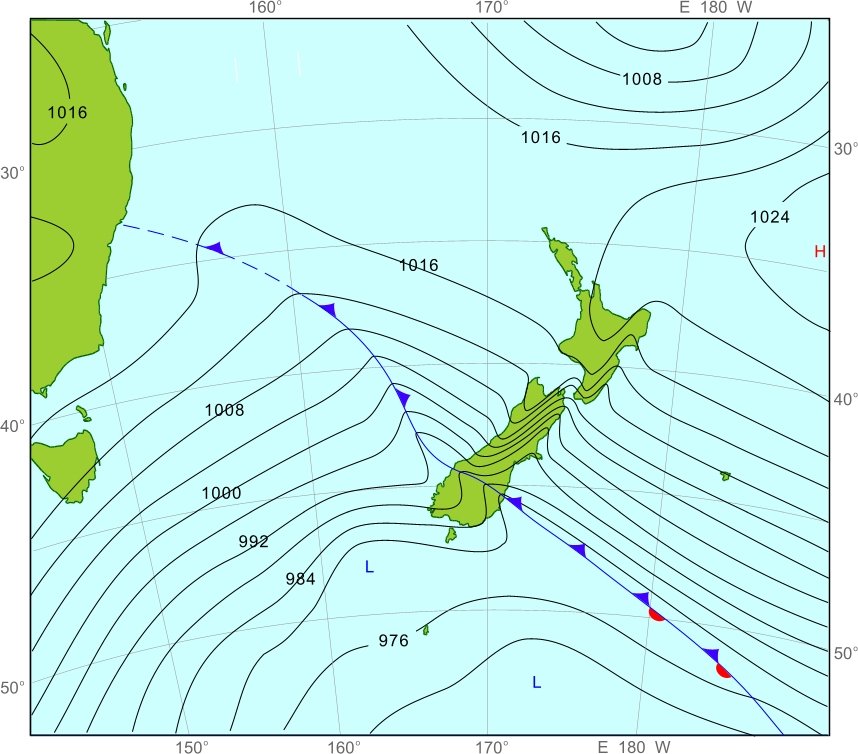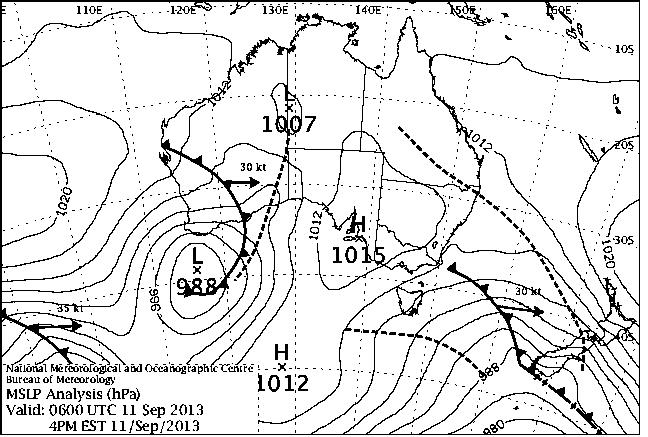The Christchurch Storm and the Moon
FRIDAY SEPTEMBER 13, 2013
Page 365 of our weather almanac for NZ for 2013 suggests disturbed westerlies and northwesterlies over the South island for 11 September. The isobaric map on the day page 382 shows the close isobars and talks about fluctuating winds. The tables on p367 and p368 show a storm sweeping across the country. This was predictable and can serve as a good example for the moon method of predicting trends.
Anyone who looks up ‘metonic cycle’ on Google will find one of the best-kept secrets in earth-science. It is the period of very close to 19 years that was part of sacred geometry for thousands of years (Wikipedia). What is remarkable is that it brings together the sun and moon as a synchronised weather prediction system. Every nineteen years the solar calendar comes exactly into alignment with the independent phases of the moon.
The metonic is named after the Greek astronomer Meton of Athens (fifth century BC) who observed that a period of 19 years is almost exactly equal to 235 synodic months and, rounded to full days, counts 6,940 days. The difference between the two periods (of 19 years and 235 synodic months) is only a few hours, depending on the definition of the year.
When Meton introduced the cycle around 432 BC, it was already known by Babylonian astronomers. The cycle was also used in ancient Chinese calendar systems (the 'Rule Cycle' ) and the medieval computus (i.e. the calculation of the date of Easter). It still regulates the 19-year cycle of intercalary months of the Hebrew calendar. There is no reason to suppose that this amazing cycle was not known by Chaldeans, Sumerians and Mayans and whichever cultures preceded them.
Ancient cultures regarded the moon as the basic measuring tool for seasons, weather, tides and more, such as times to buy and sell. The moon is clockwork and reliable, every year only losing 10 seconds to repeat its position with respect to background stars. A watch that accurate would satisfy most.
The metonic cycle features in the dimensions of known ancient stone circles, also factorial in the dimensions of the Egyptian pyramids. Stonehenge has no fewer than three 19-stone circle configurations. These are the Bluestones, the Aubrey Holes (three lots of 19) and the dimensions of the Outer Bank around which one foot of circumference represents one week of a giant 19 year circle. Stone circles in Ireland, like Dromberg, Mauhanaclea and Reaascreena use circles of 19 stones, on smaller circles but still exact reduced ratios of Stonehenge such that three inches of perimeter represents a week of a 19-year circle.
Why is this not more widely known? It is because science has become so compartmentalised, with all departments competing for funding from the same source. Archaeologists do not confer with meteorologists, and history and ancient religions is not even on the horizon. There is no incentive to combine for symposiums pooling knowledge. Modern meteorology has gone the way of satellite technology, and ironically satellites have uncovered old stone circle sites. The impressive pre-Maori stone circle at Mangonui Bluff, just out of Dargaville, which still aligns to Stonehenge, was the subject of a NASA investigation about a decade ago, something that did not get any mention in local media.
In fact old abandoned stone circles are to be found all over NZ if one knows where to look. Aucklanders would know of Stockade Hill, overlooking Howick. It was the site of a stone circle as described in council records, and the stones were removed during colonisation so a fort could be built. It is the viewing platform for an equinox marker carved into Mt Wellington, only viewable from the Hill. Another such marker is visible, if one stands in the earthwork on Mt Wellington and trains a theodolite on the treeline of the Waitakeres. It shows that the Auckland isthmus would have once housed a huge population, which logically would have fled or perished in the Rangitoto eruption.
Then there is the 2000-year old 'computer' called the Antikythera mechanism, which appears to be an ancient analogue GPS system designed to calculate astronomical positions. .A mechanical computation of the metonic cycle is built into the Antikythera mechanism. This computer, about the size of a shoebox was recovered in 1900–1901 from a Greek shipwreck but its significance and complexity were not understood until a century later. Professor Michael Edmunds of Cardiff University, led a 2006 study of the mechanism, and declared, “the astronomy is exactly right”.
This machine has the oldest known complex gear mechanism. After setting of the date on the front dial an operator would have turned the hand crank causing all 30 interlocked gears within the mechanism to rotate, resulting in the calculation of the position of the sun, moon, and astronomical information such as moon phases, eclipse cycles, and theoretically locations of planets. Of the five gear-trains employed, three utilise the metonic cycle.
So what has this to do with this week's storm? If you look in the newspaper at a weather map for any chosen day of any year, it compares very well with a weather map of 19 years previously, with an error factor of about a week. The double metonic of 38 years is sometimes an even greater match. Stone circles were weather calculator installations, the 'apps' of their day. Every village had one and they were used to predict when to plant and harvest. Each year over a five-year span this author visited and surveyed upwards of 50 ancient stone circles across the UK. it was found that all were and still are aligned to the moon and utilise some aspect of 19 in either stone numbers or site dimension.
It is still the practice of shamans in ancient cultures to construct their own secret circles away from prying eyes of villagers. The location is hidden, only to be shared with initiates, because such knowledge is more important than life and death. Such a stone construction has to be watched and added to with marker sticks every week for 19 years. (People were kept away from European circles by ditches and deep moats). When, after a dry spell, a storm is calculated to be returning, the shaman invites the villagers to do the rain dance. Until a few days beforehand he says not yet, not yet. The villagers dance when told to, and make a lot of noise, and the rain arrives within a few days. Of course the dance is given the credit.
The priest/astronomers are the village “wise men”. Their techniques are ancestral to the astrology that followed, which further refined weather predictions, all based around orbits of the moon. Not just the one metonic cycle was utilised in weather predictions but as many as five variants, pulses and multiples, each covering different weather aspects. One provided how many rain days there would be in a month, another the timing of weather events and a third was part-utilised for earthquakes.
To find examples of the efficacy of the metonic cycle one is only restricted by time given to exploration. On 8 September 1991, a 6.3mag earthquake occurred in Manawatu, felt throughout the NorthIsland. Compare this to 4 September 2010, 19-years later. In 23 May 1994 came the worst wind storm ever to hit Perth. In May of 2013, 19 years later, winds of 130kph revisited Perth and left 6000 homes without power. The summer of 1975 was the driest for 150 years in Ulster; the same has happened this year, 38 years, the double metonic, later. And the last time the winds were as destructive in Canterbury was in the early spring of 1975.
That may be a sheer fluke, or may not.
Actually, there are no concidences in science, because science is there to investigate reasons for everything. 'Fluke' and 'random' are words more commonly found in casinos.
Below: the equivalence of 1975 and 2013

